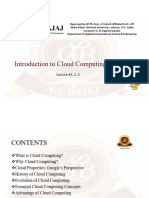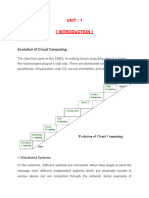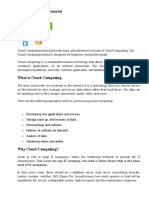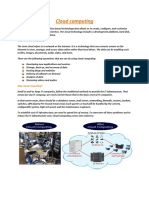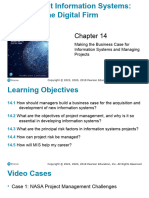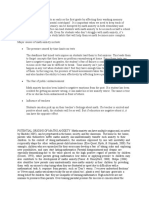Unit 1
Cloud Computing & its Objective
What Is Cloud Computing?
Cloud Computing means storing and accessing the data and programs on remote
servers that are hosted on the internet instead of the computer's hard drive or local
server. Cloud computing is also referred to as Internet-based computing, it is a
technology where the resource is provided as a service through the Internet to the user.
The data that is stored can be files, images, documents, or any other storable
document.
Objectives -
# Enabline Technologies
Objectives of Cloud Computing Key Enabling Technologies of Cloud Computing:
1. Virtualization
1. Cost Efficiency & Resource Optimization
Allows multiple virtual machines (VMs) to run on a single physical machine.
Reduce IT infrastructure costs by providing scalable, pay-as-you-go services. Optimize resource
Enables efficient resource allocation and scalability.
utilization to enhance performance while minimizing expenses.
Examples: VMware, Microsoft Hyper-V, KVM.
2. Scalability & Flexibility
2. Distributed Computing
Enable businesses to scale resources up or down based on demand. Support dynamic
Breaks tasks into smaller units and processes them across multiple machines.
workloads without requiring significant hardware investments.
Improves performance, fault tolerance, and reliability.
3. Accessibility & Collaboration Examples: Hadoop, Apache Spark
Provide remote access to data and applications from anywhere with an internet connection. Service-Oriented Architecture (SOA)
Enhance teamwork and productivity through cloud-based collaboration tools. Organizes software as a set of services that communicate via APIS
Enables integration of different cloud-based applications.
4 Security & Reliability
Example: Microservices in cloud applications.
Ensure data protection through encryption, authentication, and compliance with security
4. Networking Technologies
standards. Offer reliable backup, disaster recovery, and uptime guarantees.
Enables data transfer and communication between cloud resources.
of
Includes high-speed internet, SDN (Software-Defined Networking), and VPNs for secure
Computing
access.
# Featurs Cloud Example: AWS Direct Connect, Google Cloud Interconnect.
Data 5. Storage Technologies
01 06 Provides scalable, redundant, and efficient storage solutions.
Resource Pooling Automatic System
Includes block storage, object storage, and file storage.
On-Demand Economical Example: Amazon S3, Google Cloud Storage.
Self-Service 02 07
Easy Maintenance 03 Features of 08 Security
# Charactesstics
Cloud Computing
Large Network
Large Net 04 09 Pay As You Go
Availability 05 10 Measured service Characteristics of Cloud Computing:
1. Resources Pooling
It means that the Cloud provider pulled the computing resources to provide services to
Figure 1:
Features: multiple customers with the help of a multi-tenant model. There are different physical and
virtual resources assigned and reassigned which depends on the demand of the customer. The
Cloud computing brings a number of new features compared to other computing paradigms. There
customer generally has no control or information over the location of the provided resources
are briefly described here:
Scalability and on-demand services
but is able to specify location at a higher level of abstraction
2. On-Demand Self-Service
Cloud computing provides resources and services for users on demand. The resources are
scalable over several data centers. It is one of the important and valuable features of Cloud Computing as the user can
User-centric interface continuously monitor the server uptime, capabilities, and allotted network storage. With this
feature, the user can also monitor the computing capabilities.
Cloud interfaces are location independent and can be accesses by well-established interfaces
3. Easy Maintenance
such as Web services and Internet browsers.
Guaranteed Quality of Service (QoS)
The servers are easily maintained and the downtime is very low and even in some cases,
there is no downtime. Cloud Computing comes up with an update every time by gradually
Cloud computing can guarantee QoS for users in terms of hardware/CPU performance,
making it better. The updates are more compatible with the devices and perform faster than
bandwidth, and memory capacity.
older ones along with the bugs which are fixed.
Autonomous system
4. Large Network Access
The cloud computing systems are autonomous systems managed transparently by users.











